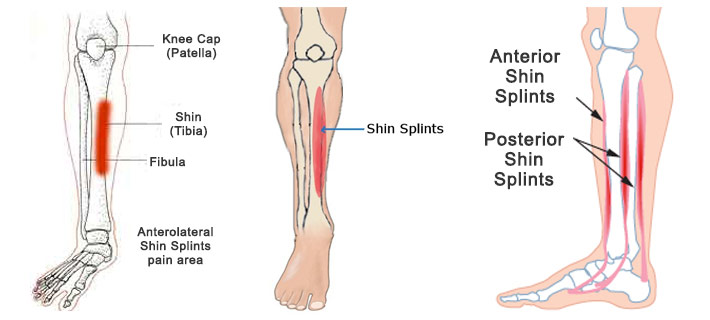You develop shin splints when you experience pain in the front of your lower leg. The pain you experience is because the tendons, muscles, and bone tissue around your shin become inflamed. These types of injuries are quite common in gymnasts, runners, military recruits, and dancers. It is important to understand causes of shin splintsto be able to determine the best way to treat them.
What Causes Shin Splints?
You experience pain when you engage in activities that put excessive pressure on the shinbone as well as the tissues that connect the muscles to the shinbone. The excessive pressure leads to the swelling of the muscles, which increases the pressure against the bone. This makes you feel pain and inflammation.
Shin splints may also be the result of stress reactions to bone fractures. Engaging in certain activities may put excessive pressure on the bone and even cause cracks in the bones of your leg. You need to take plenty of rest to give your body time to repair the cracks. Not giving your body enough time to recover may lead to a complete fracture.
Some other causes of shin splints include insufficient flexibility, anatomical abnormalities, muscle weakness in the buttocks, and wrong training techniques. To avoid dealing with shin splints, you need to avoid putting extreme force on the shins. It means you have to be extremely careful when running downhill, wearing running shoes, and running on a slanted surface. Sports that have fast stops and starts may also put excessive pressure on your shinbone.
Risk Factors for Shin Splints
It is important to understand what causes shin splints, but you also need to keep in mind that some people are at a greater risk of developing these problems. For instance, you are more likely to develop shin splints if you have a very rigid foot arches or you have flat feet. Not wearing proper shoes and working out on hard surfaces make you more susceptible to developing shin splints.
What Are the Symptoms of Shin Splints?

Once you develop shin splints, you will experience certain symptoms as well. For instance, you will experience a dull ache in the front of your lower leg as well as muscle pain. The pain usually develops during exercise and is usually on either side of the shinbone. There will also be pain and tenderness along the inner part of your lower leg. Swelling in the lower leg and numbness in the feet are other common symptoms of shin splints.
You should go see your doctor if homecare measures do not improve your condition. Seek immediate medical attention if you have severe pain in the shinbone, your shin feels hot, or your shin is visibly inflamed and swollen. If there is pain in your shin even when you are resting, it is time to go see your doctor immediately.
How Can Shin Splints Be Treated?
Knowing what causes shin splints is important, but it is equally important to understand how to treat this condition.
- Rest: Taking a break from an activity that may have caused this injury in the first place will help improve your condition. You will start to feel better in a few days, but you should only return to such sporting activities that do not put serious pressure on your legs. Walking and swimming are good options.
- Ice application: To relieve swelling, you may consider using icepacks. Apply icepacks on your shin for about half an hour every 3-4 hours for a couple of day to reduce swelling.
- Medications: Similarly, you can consider taking anti-inflammatory painkillers, like naproxen, ibuprofen, or aspirin. Do not use them for extended duration because they can have side effects and cause ulcers and bleeding.

If pain persists, see your doctor who will examine you and may even ask for x-rays and bone scans. Your doctor will prescribe medication and may also recommend the use of orthotics. Shoe inserts help a lot, especially when your arches flatten when you stand up. They will also explain what exercises you can perform to improve strength and flexibility. A physiotherapist may also help improve your condition. In rare cases, you need surgery to treat your stress fractures.
Sings You Have Been Healed
The following signs suggest that your shin splints are now healed and you can return to normal activities:
- There is no difference in flexibility between your injured leg and your other leg.
- There is no difference in strength between your injured leg and your other leg.
- There is no pain when you sprint, jog, and jump.
Your doctor may still order x-rays to confirm that there are no signs of stress fractures. How long it takes to recover from shin splints usually depends on what causes shin splints in the first place.
How Can I Prevent Shin Splints?
You can take a number of steps to prevent shin splints and keep them from getting worse. For instance:
- Always wear the right shoes when engaging in sporting activities.
- Consider using arch supports if you have flat arches.
- Consider engaging in different sporting activities to lessen the impact on your shins.
- Try strength training with your sporting activity to strengthen your calf muscle.
- Always take some time to warm up your body and then start your exercise.
- Be sure to stretch your muscles before you start training.
- Do not increase the intensity of your training suddenly.
